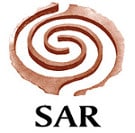 SAR News:
SAR News:SANTA FE ― The Indian Arts Research Center (IARC) turns 40 this year and is celebrating the occasion with a festive event June 22 at the Poeh Cultural Center in Pojoaque Pueblo.
Themed “Honoring Forty Years of Creativity in Native American Arts,” the evening features a presentation by artist Nora Naranjo Morse, music, food prepared by a Native American chef, and a live and silent auction of select work by past SAR artist fellows. Proceeds from ticket sales and the auctions will go directly toward IARC educational programming.
The IARC also will honor Naranjo Morse with a lifetime achievement award for her accomplishments in the arts and her support of the IARC.
“In celebrating our fortieth anniversary, we wanted to take this opportunity to honor an artist who not only made a significant impact on the Indian Arts Research Center, but also on the art world as a whole,” IARC director Brian Vallo said. “We wanted to acknowledge a person who challenges ideas of what it means to be an artist while still remaining grounded in their community. For us, Nora Naranjo Morse—a sculptor, builder, and poet from Santa Clara Pueblo—represents all these qualities.”
The event marks the establishment of the IARC on the SAR campus and recognizes the creativity of Native American artist fellows, their accomplishments, and the last forty years of innovative IARC programming. Designed to serve as a permanent home for the Indian Arts Fund collection, whose history extends all the way back to 1922, the IARC was built as a storage and research facility to promote Southwestern Native American arts. Since its establishment in 1978, the IARC has served as a resource for scholars, artists, and most importantly, the source communities represented in the collection.
Forty years later, the IARC remains committed to fulfilling its primary focus of stewardship of, and providing access to, the collection. Now home to more than 12,000 pieces, the collection has grown thanks to generous donations from private collectors and artist fellows. Through seminars and symposia, the IARC has also become a safe space for discourse on critical issues among Native American artists, tribal leaders, and scholars. The signature intellectual training programs and Native Artist fellowships for seventy-four fellows to date, combined with varied initiatives and public programming, continue to set the IARC apart from other similar institutions.
To celebrate this momentous occasion in SAR history, the IARC will host events throughout the year that celebrate the scholarship and achievements of its artist fellowships and intern programs, while honoring the living history and traditions of local Native American communities.
In February, a three-part documentary series was produced by the New Mexico PBS show ¡COLORES! in partnership with the IARC. Filmed inside the IARC vaults, the documentary featured consummate pueblo potters Maria Martinez (San Ildefonso), Lucy M. Lewis (Acoma), and Helen Cordero (Cochiti), and highlighted masterpieces from the IARC collection that were created by the three potters.
The 2018 IARC Speaker Series, Trailblazers and Boundary Breakers: Honoring Native Women in Art, examines the indelible impact and explores the often-untold stories of Native American women in art. Through lecture and discussion, speakers will share their knowledge and experience in these topics. This series is open and free to the public.
For more information, visit speakerseries.sarweb.org. The series is dedicated to the many accomplishments of well-known artist Nora Naranjo Morse, who was the 1988–1989 Katrin A. Lamon Artist Fellow and 2000 Ronald and Susan Dubin Fellow at SAR.
“As a Dubin fellow, I was awarded a three-month stay on the SAR campus. This award came at a time when I was in an artistic transition and afforded me the time and space to explore new art concepts while looking through SAR’s important pottery collection. In doing this, I was inspired by the timeless spirit of the pueblo clay work made by my people who, in their own way and at specific time periods, articulated their cultural experience,” Naranjo Morse said. “Since my fellowship, I have revisited SAR, attending lectures and revisiting the collection. SAR is an important resource; it holds aspects of cultural knowledge for contemporary artists looking to expand their creative vision and cultural understanding.”
For more information on any of the IARC’s 40th anniversary events or to purchase tickets for the June 22 celebration, visit sarsf.info/iarc40.

